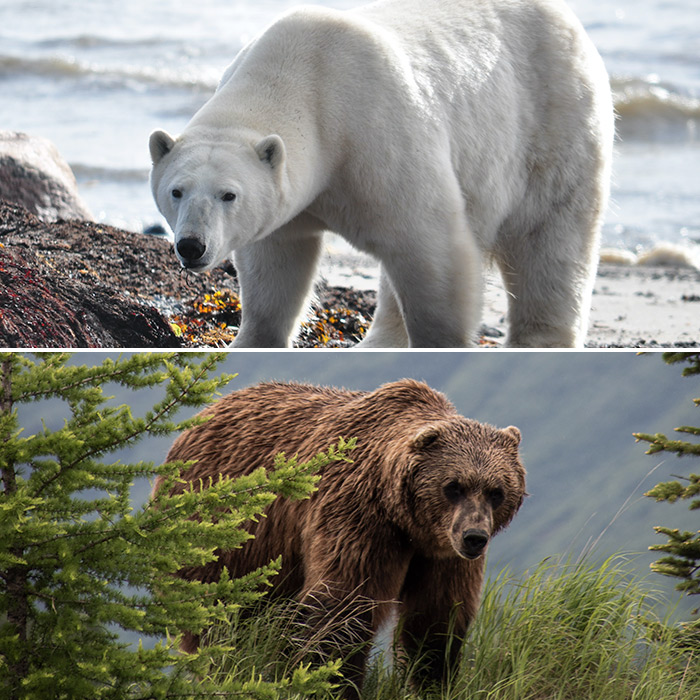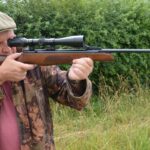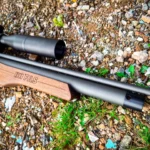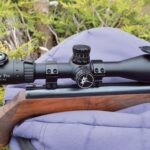
Yes, it’s time to answer the age-old question of who would win in a fight: the ferocious grizzly bear of sub-Arctic North America, or the hulking polar bear from the frozen tundra.
Both are formidable opponents, as they both sit on top of their respective food chain, but what if these two were to meet each other in less-than friendly circumstances?
How would their differences in stature and hunting strategies measure up? In order to answer this question, we will have to take a closer look at each animal’s individual stats.
Table of Contents
The Weigh-In
Height
5-8’ 7-10’
Weight
400-1000 lbs 775-1,300 lbs
Paw Width
7” 12”
Claw Size
2-4” 2-4”
Bite Force
975 PSI 1200 PSI
Speed
35mph 25mph
As you can see from the table above, the polar bear has a HUGE advantage in size. Quite simply, they’re massive.
With their extreme size and weight, they are perfectly evolved to endure the harsh winters of their arctic habitats.
Polar bears do not really hibernate, because the Fall and Winter months provide the best environment for accessing food.
This is because when the ice forms, the bears have access to their main food source: the seal.
They are able to venture further out from land and hunt in the seal-rich waters.
Furthermore, their thicker fur and fat supplies make them a harder target to defeat, as teeth and claws have a much farther distance to go in order to do any damage.
While still being huge, the Grizzly is a much leaner predator.
Their size is more suited for warmer climates, thicker vegetation and faster prey.
The Grizzly does not have the same need for insulation that the polar bear does because unlike polar bears, they hibernate during the cold months.
Oppositely to their arctic cousins, Winter is a lean season for the Grizzly, as migratory animals move south and food becomes scarce.
Paws and Claws
In order to support their great size, their paws need to be huge as well.
Also, their broad size gives them much needed traction as they traverse snow drifts.
Their paws also make them incredibly adept swimmers, as they work like flippers and help propel them to hunt aquatic prey.
Claws, on the other hand (pun intended), the Grizzly might see a slight advantage.
While being roughly the same size, the Grizzly’s claw is built for digging and doing damage to any opponent it might face in the wild.
The polar bear’s claw is more built for giving traction in the snow, and for taking hold of seals, which make up most of its diet.
Much like the polar bear, seals have large fat reserves to insulate them from arctic climates. Because of this, polar bears’ claws must be good at grabbing hold of them so they can then eat them.
A sharper, more slender claw might eviscerate their prey’s flesh, but cause them to lose it in the ocean in the process.
As far as paw size, the polar bear has the advantage.
Mouth and Bite Force
Not only is their mouth much larger, but their teeth are more designed for delivering the fatal blow than the Grizzly’s.
As mentioned before, grizzly bear’s claws are the most powerful weapons in its arsenal.
As the Grizzly’s diet is more varied, it has more rounded molars than the polar bear.
This helps the Grizzly grind down vegetal food in the absence of live prey.
Now, let’s talk about bite pressure.
Measuring at 1200 PSI, there are only a few animals on earth that have a greater bite force than that of the polar bear (the top of the list being the saltwater crocodile).
Not to say the grizzly bear’s bite is weak, as it certainly is not. At 975 PSI, it is only a few spots down from the polar bear in ranking.
But what do these numbers mean?
In more practical terms, these animals can easily bite through a cast iron pan, a cinder block or even a bowling ball. Imagine what it would do to you!
The polar bear has the advantage when it comes to mouth and bite force
Head Games
On the topic of robustness of skulls, this one goes to the Grizzly.
Their heads are built like a battering ram with incredibly thick bone all around.
In fact, their skulls have been known to deflect rifle bullets.
They are built for fighting and raw aggression.
Polar bears have much more slender skulls in comparison.
This makes them more streamline in the water, making them stronger swimmers, but more vulnerable to trauma in the head region.
Even with the polar bear’s stronger bite force, if a fight were to be decided by a head chomp, it might go in the favor of the Grizzly.
Speed
If the fight comes down to a chase, or they decide to settle the squabble peacefully with a good old fashioned woodland foot race, the grizzly would once again have the advantage.
A common misconception with grizzly bears is that they’re big and slow. In fact, they are big and fast, clocking in at 35mph!
That means a bear could run the entire 360 foot length of a football field in 7 seconds!
It’s huge paws and streamline body make a swimmer of Phelpsian proportions.
If the race is a swim-off, than the polar bear is going to edge out the competition.
Agression
Both are incredibly aggressive creatures and would have no problem with defending themselves if provoked.
There have been more accounts of humans being attacked by grizzly bears, but that is mostly due to the population density in which they live.
However, polar bears alone claim a very impressive title: they are the only species on earth that considers humans food.
While other animals are known to attack, kill and eat humans, this is usually due to provocation.
Polar bears see humans as a viable food source and will stalk and hunt people as a means to survive in the barren arctic.
I’m calling this one a draw.
Intelligence
The polar bear is widely regarded as one of the planet’s most intelligent hunters.
Their ability to stalk prey over long distances and outsmart and outmaneuver makes them absolute master tacticians.
Seeing as how they often use their wits to prey on humans speaks volumes to their prowess.
If our Ursidae melee involves some level of hide and seek, the decision would go to the polar bear.
Strengths & Weaknesses
Both animals are evolutionary masterpieces and are perfectly equipped to reign supreme in their respective habitats.
This means that their strengths may prove to be weaknesses if transplanted into a different environment. And vice versa.
For example, the polar bear has incredibly dense fur and heavy fat reserves. It is perfectly suited for life in the arctic.
However, if you were to bring a polar bear into a sub arctic summer, it would tire easily and need to cool down before long.
They are bears from very different environments, which makes it difficult to parse out strengths and weaknesses.
Final Verdict
If we were to somehow create a neutral arena, one that plays to neither the polar or the grizzly bear’s advantages, we would have a very even fight, despite the size difference.
If it came to a close-quarters brawl, the polar bear might have an advantage.
While not possessing the sharp claws of the grizzly, its huge paws and strength could deal a fatal blow to the smaller opponent.
It’s thick coat and skin would help shield against any minor lashes from the grizzly.
If the polar bear gets close enough to use its powerful jaws, it might be a done deal.
However, if the grizzly bear can get a bit of distance, its speed could prove to be a huge advantage.
Quicker and more mobile than the hulking polar bear, it could dip in for quick strikes and tire it out.
If we’re not talking about an all-out brawl, this could all change.
As mentioned before, polar bears are master hunters and swimmers.
If this fight were to happen in an uncontrolled environment with each animal’s location being unknown, the polar bear would edge out the grizzly bear.
In real life?
There have been no recorded instances of a grizzly fighting a polar bear, but over the last decade there have been sightings of either encroaching on the other’s territory.
As climate change continues to thaw the polar ice drifts, grizzlies have been seen venturing further into polar bear territory.
While this may pique the interests of those wanting a battle royale between these two juggernauts, it almost certainly spells disaster for the future of their kind.
As human’s impact on the earth’s environment continues to worsen, these habitats are being destroyed and food sources are being depleted.
So, if you ever witness a grizzly fighting a polar bear, it’s not a great sign.
Final Thoughts
On the topic of who would win this battle, I have to defer to environmental variables.
Both are perfectly in tune with their habitat and will surely be victorious if this fight happens on home turf.
Nature always proves to be more complex, and less generous with easy answers than we hope, but can keep thinking about it all the same.











































